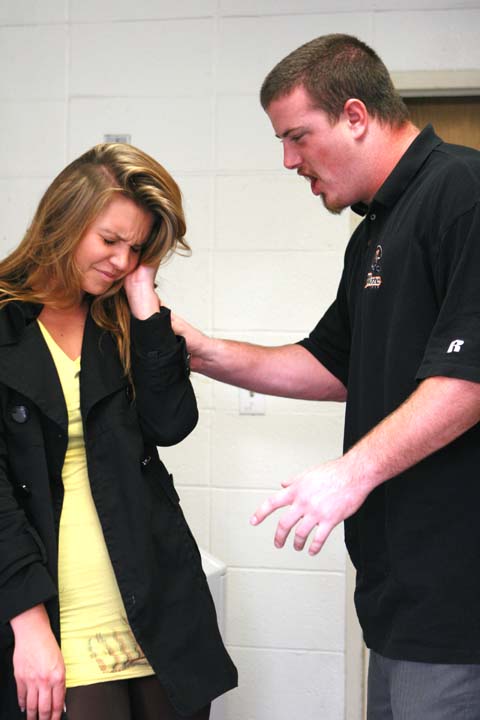 Kallie Larsen / Staff Photographer
Kallie Larsen / Staff PhotographerAn abuser could be compared to a malignant cancer that continuously eats away 8212; it has a permanent presence with no treatment. Relationship abuse is an ongoing issue among youths and adults and it is often forgotten that an intimate partner should offer a safe haven. A relationship should make one feel valued, loved and feel equivalent to spending time with a best friend.
Occasionally, one will hear stories of dysfunctional relationships and abusive partners, but these accounts sometimes seem distant and make individuals feel like such behavior won’t happen to people they know.
According to the 2006 Allstate Foundation National Poll on Domestic Violence, nearly three out of four (74 percent) of Americans personally knew someone who was or had been a victim of domestic violence. Thirty percent of Americans said they knew a woman who had been physically abused by her husband or boyfriend in the previous year.
This kind of abuse doesn’t necessarily mean being physically hit; it can come in emotional and sexual forms, which are sometimes not easy to detect. These coercive behaviors are used to maintain power and control of a former or current intimate partner. No form of abuse is worse than the other.
Physical
Physical abuse is often the easiest to identify because of the evidence of bruises and scars. While there may not be marks when the victim is grabbed by the arm, shaken or pushed around, these actions can be considered physical abuse. Women should be aware of cycles of abuse. According to clinical psychologist Dr. Joanne J. Wendt, an abuser will lash out and be mean-spirited or extremely violent.
After this behavior is done, they try to win the victim back by doing very generous things such as showering them with gifts and promising not to hurt them again. Then another issue arises and abuse occurs again. It has led to the deaths, hospitalizations and countless injuries of many victims. According to the Bureau of Justice Statistics Crime Data Brief, “Intimate Partner Violence 1993-2001,” on average, more than three women and one man are murdered by their intimate partners in this country every day.
“The only person who usually gets help is the victim,” Wendt said. ” (This occurs when the victim) calls the police or goes to a shelter.”
Emotional
For most survivors, emotional abuse is difficult to describe or discuss. They often wonder if it is serious because it isn’t visible by bruises or broken bones. However, the effects of emotional abuse can be damaging and cause survivors to have long-term issues with trust. Control is a huge part of emotional abuse and involves chronic anger, jealousy, accusations and distrust. According to Wendt, the more common form of abuse she encounters is emotional. She emphasized that victims are frequently made to feel worthless, with abusers emphasizing their weaknesses.
“It can happen to anyone with a different race, religion and economic status,” Wendt said. “It’s across the board, from financial frustration to in-law problems.”
Emotional abuse can often be mistaken for intense or passionate love; however, it is not the same. One sign of emotional abuse includes making a significant other feel bad or apologetic when they spend time with friends. This can lead to feelings of isolation, as the victim will feel as though they cannot hang out with friends without feeling guilty.
Sexual
This type of abuse is also difficult to identify and can happen to anyone, men and women alike. It is any form of touching, intercourse or exploitation of one’s body. This includes taking pictures for sexual purposes, asking a person to touch someone else’s private parts and making sexual references to one’s body. It’s never right to force anyone into an unwanted sexual experience and it is considered unlawful.
Why it happens
According to Wendt, people who end up in abusive relationships come from families with this kind of relationship. They are typically dysfunctional families, which leads the children to grow up not knowing how to properly handle situations.
“Sometimes the abusers don’t know they came from an abusive family,” Wendt said. “So the kid comes away not knowing how to be kind and gentle. They only know how to be demanding, critical and (use) name-calling and this is how a child will learn.”
Wendt said an individual who grew up in a normal, functional family would walk away from an abusive relationship, whereas an individual from a dysfunctional family is more likely to stay with an abusive partner because it’s what they are used to.
“I was interviewing a teen who had bruises on her arm and she said it was from (her) brother,” Wendt said. “No one was ever there to stop it. And the girl said that’s what everybody does and said it happens to her friends too. (She believed) being battered around was OK. It’s not OK and they just don’t know that.”
“It tears away at a person’s self-worth,” Wendt said. “(They believe they have) no value, they don’t go do anything for themselves. (They) become depressed and withdraw and don’t want to try. It just destroys the drive to better themselves.”
For information regarding abuse hotlines call National Domestic Violence Hotline at 1-800-799-SAFE or visit www.enddomesticabuse.org.









